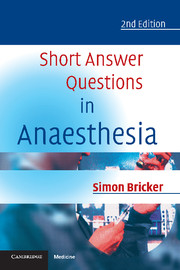Book contents
- Frontmatter
- Contents
- Preface
- Preface to the 1st edition
- Abbreviations
- 1 Advice on answering short answer questions
- 2 General Anaesthesia
- 3 Anaesthesia and Medical Disease
- 4 Medicine and Intensive Care
- 5 Obstetric Anaesthesia and Analgesia
- 6 Paediatric Anaesthesia
- 7 Neuroanaesthesia
- 8 Acute and Chronic Pain
- 9 Trauma and Emergency Anaesthesia
- 10 Anatomy, Applied Anatomy and Regional Anaesthesia
- 11 Pharmacology and Applied Pharmacology
- 12 Clinical Measurement and Equipment
- 13 Cardiac and Thoracic Anaesthesia
- Index
11 - Pharmacology and Applied Pharmacology
Published online by Cambridge University Press: 05 February 2014
- Frontmatter
- Contents
- Preface
- Preface to the 1st edition
- Abbreviations
- 1 Advice on answering short answer questions
- 2 General Anaesthesia
- 3 Anaesthesia and Medical Disease
- 4 Medicine and Intensive Care
- 5 Obstetric Anaesthesia and Analgesia
- 6 Paediatric Anaesthesia
- 7 Neuroanaesthesia
- 8 Acute and Chronic Pain
- 9 Trauma and Emergency Anaesthesia
- 10 Anatomy, Applied Anatomy and Regional Anaesthesia
- 11 Pharmacology and Applied Pharmacology
- 12 Clinical Measurement and Equipment
- 13 Cardiac and Thoracic Anaesthesia
- Index
Summary
Compare and contrast Ametop (amethocaine gel) and EMLA cream. Are there any dangers associated with their use?
EMLA is a significant drug in paediatric practice, but it is commonly prescribed automatically on paediatric wards and applied by the nursing staff. Ametop is a more recent preparation which can be supplied without prescription. This question assesses both basic pharmacological and clinical knowledge of two useful drugs.
Introduction
The introduction of effective topical analgesia to ameliorate the pain of venepuncture has been a very important innovation in paediatric anaesthesia. There are two preparations available: EMLA, which has been available for over 15 years, and Ametop (amethocaine gel), which is a more recent introduction.
Chemistry
Amethocaine (tetracaine)
Ester linked local anaesthetic.
Ametop is a 4% formulation produced as a white opalescent gel, containing 40 mg ml–1 of tetracaine (amethocaine) base.
Onset: application for 30 minutes allows venepuncture; for 45 minutes allows intravenous cannulation.
Duration: analgesia persists for 4–6 hours after gel removal.
Produces some vasodilatation.
Amethocaine is toxic and maximum dose should not be exceeded.
Is not a prescription only medicine (POM).
EMLA (eutectic mixture of local anaesthetic)
A eutectic (Gk eutektos – ‘easily melting’) mixture is one in which the mixing of two substances of the same consistency produces a mixture of different consistency. This is related to an alteration in the melting point of the mixture: an example is ice and salt, which when mixed produce water.
- Type
- Chapter
- Information
- Short Answer Questions in Anaesthesia , pp. 273 - 296Publisher: Cambridge University PressPrint publication year: 2002



